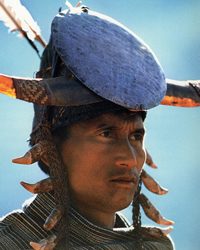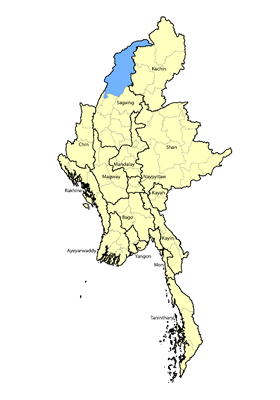A major complication with identifying this group is caused by the fact that almost all other ethnicities know them as “Yongkon,” which is the name of their main village. The people themselves use Kon as the name of both their tribe and language. A small number of Kon people live across the border in the northeast Indian state of Arunachal Pradesh, where Kon men wear distinctive circular bamboo caps decorated with wild boar tusks and hornbill feathers. Numbering just 168 people in the 2011 Indian census, they have been given official status as a Scheduled Tribe of India under the name Yongkuk Tangsa.
Location: With a population approaching 2,000 people, the Kon tribe resides in and around the small town of Dunghi, which is part of Nanyun Township in western Myanmar’s Sagaing Region. A 2012 linguistic survey found there were 1,701 Kon people living in Dunghi, primarily in the villages of Yongkon (73 households), Kyawang (70), Kyawang Nukvuk (50), and Miku (50). These villages have been established for centuries but have decreased in population as people have moved to urban areas and places with more fertile land.
Language: The Kon language, which may divide into three dialects in Myanmar, shares only a 49 percent lexical similarity with Shecyu, which is considered a premier dialect for Scripture translation that linguists hope will be used by many Tangshang tribes. This means the Kon will need access to their own or a more closely related translation to be able to comprehend the Bible. Some sources suggest the Kon language is one of three main branches of Konyak Naga.
The Kon have traditionally been divided into several clans, some of which were forbidden to intermarry with each other. Village elders are selected to keep order and administer justice in the community. For centuries the Kon people were driven to headhunting by the demonic spirits they worshiped as protectors of their communities. It was said that “The Kon offered heads directly to the spirits with prayers for good crops, and in addition, the hands and feet of victims were chopped up into small pieces, mixed with rice, scattered around the village, and as this was being done, the people prayed for prosperity and health.”
A visitor to a festival in 2002 was thrilled when Kon women performed a traditional dance, “with each carrying a peculiar flute made from a horizontal section of bamboo with a central raised mouthpiece. These flutes are said to have been given to them by the spirits and were apparently used by the Kon people. In this dance, the girls, led by a single man at the head of the line, formed a long line facing inwards, and after a short time playing on the flutes, turned sideways and set off on a long snake-like dance, gradually shuffling forward in a series of knee-bends while still playing their flutes…each dancer perfectly coordinated with the one behind.”
The Kon are rare among Tangshang and Naga-related tribes in both Myanmar and India in that most people were converted to Buddhism centuries ago. For centuries Animism held sway as the religious worldview of the Kon tribe. Appeasing the spirits spilled over into many areas of people’s daily lives, especially key community events such as births, weddings, and funerals. Until recently infant Kon girls were given unique tribal face tattoos when they were seven to twelve months old. The Kon claimed: “The pattern was used to protect them from evil spirits, to ensure they would be accepted by their ancestors after death, and to make them less attractive to raiders from other groups.”
Today approximately one in five Kon families are believed to follow Christ. While three of the four largest Kon villages in Myanmar are Buddhist, the 50 households of Miku village are Baptists. In Myanmar the government gives certain benefits to Buddhists that are not available to Christians or other non-Buddhist people.
Scripture Prayers for the Kon in Myanmar (Burma).
| Profile Source: Asia Harvest |











